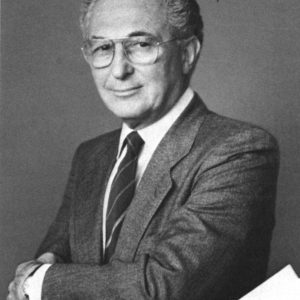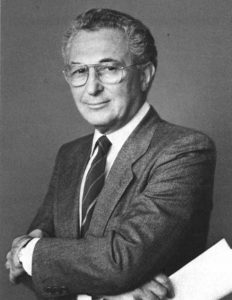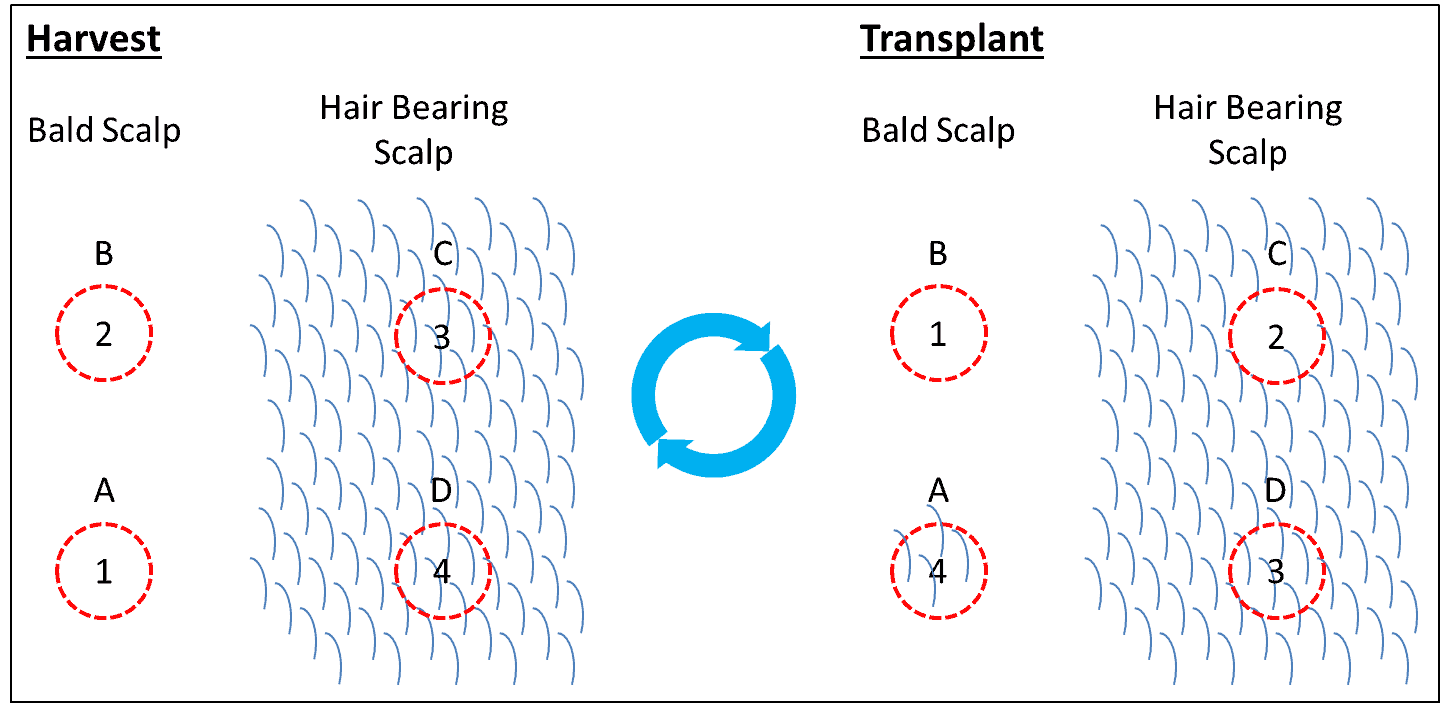
Introduction
We at Sure Hair would like to honour the achievements of one of the founding researchers of Hair transplantation, Norman Orentreich (Fig 1) (1). Norman Orentreich developed the first and only permanent solution to hair loss making him truly the father of hair transplantation. He discovered that hair maintains its characteristics even when taken from the donor area and implanted elsewhere. This theory was termed “donor dominance” and is what makes hair transplantation possible.
Figure 1. Norman Orentreich MD.
A singular treatment
Humans experience various forms of hair loss all with differing causes. The primary form of hair loss is androgenetic alopecia (male- and female-pattern baldness). In men with this form of hair loss, the follicles become sensitive to the hormone dihydrotestosterone and fail to continue producing hair. This pattern manifests as a receding hairline and balding crown. In female-pattern baldness the causative agent is poorly understood, although androgen hormones are believed to still play a role. The pharmaceutical treatment for androgenetic alopecia is to control the androgen levels in the scalp. Treatments like minoxidil and finasteride are effective; however, the treatment must continue as any retained hair is lost when treatment stops. The other major cause of hair loss is alopecia areata. Alopecia areata is an autoimmune related form of hair loss where the immune system attacks the follicles and can affect parts of, or entire, scalp. Alopecia areata was historically controlled by modulating the immune response through corticosteroids. Orentreich sought to develop a singular treatment, hair transplantation, which could be used for all forms of hair loss.
Figure 2. Donor dominance. Cartoon depicting the punch graft transplantation pattern that was used to demonstrate donor dominance. Regions A and B are located on bald scalp while regions C and D are located on hair bearing scalp. Four punch grafts were harvested (1-4) from regions A-D. The grafts were then implanted in one clockwise position: 1 to B, 2 to C, 3 to D, and 4 to A. Region B accepting Punch 1 demonstrates that bald scalp is able to accept bald punch grafts. Punch 2 at Region C demonstrates that hair bearing scalp does not fill in bald punch grafts. Punch 3 at Region D demonstrates that hair bearing scalp is able to support hair bearing punch grafts. Most crucially, Punch 4 at Region A demonstrates that bald scalp is able to accept hair bearing punch grafts.
A brilliant design
Orentreich’s experimental design consisted of taking punch grafts from adjacent regions to determine if the graft would remain viable. A grid was set up which included hair bearing scalp and bald scalp with the regions marked with letters, A-D (Fig 2). Punch grafts were taken and indicated by numbers 1-4. The punches were then implanted in a clockwise fashion such that the following combinations were created: bald into bald, bald into hair, hair into hair, and hair into bald. By designing the experiment in this way, each recipient region provides a control, to ensure that a graft is even acceptable. Orentreich determined that bald or hairy scalp were both able receive grafts and that hair bearing punch grafts could continue to grow hair, even when implanted in bald scalp (1).
The fascinating observation from this work was that when hair follicles were transplanted, the hair grafts maintained their characteristics. These characteristics included: length, texture, curl, colour, and most importantly longevity. Excitingly it was determined that any grafts that were harvested from the so called “safe zone” (where hair was not susceptible to blading or thinning due to androgenetic alopecia) remained healthy after implantation. In a rigorous effort Orentreich transplanted various combinations of hair and began to develop a theory regarding the characteristics of hair. The final experiment defined in his 1959 paper was the reconstruction of a hair line with twelve 4 mm punch grafts. The plugs were monitored for 4 years prior to publication and did not show any signs of thinning or loss of density (1,2). The sum of this work was termed “donor dominance” and hearkened in the era of hair transplantation (1,3,4).
Contributions
Orentreich’s contributions did not cease after his 1959 paper. He went on to develop Head and Shoulders Shampoo™ in 1961, revolutionizing the treatment of dandruff and later starting the Clinique™ brand of skin and hair care products (2,5).
Orentreich continued to be dedicated to his research, publishing dozens of impactful papers on alopecia. For the treatment of alopecia areata, an immune related form of hair loss, Orentreich researched the use of corticosteroids. In one of his definitive works, he determined, without question, the effectiveness of corticosteroids in 500 patients (6). The use of corticosteroids is still in practice today (7).
Additional work on alopecia areata by Orentreich was the discovery of antibodies to hair follicles and comparing these antibodies in normal individuals with active alopecia areata. They found that there was a definitive increase in antibodies towards hair follicles in patients with alopecia areata. Interestingly, they found that there was still a low level of expression of antibodies to hair follicles in normal patients, albeit the class of antibody was different. To date it is not understood what the role of these antibodies play in normal individuals (8,9).
Life long pursuit
Orentreich was able to pursue his other passion, research into increasing lifespan through founding the Orentreich Foundation for the Advancement of Science. With his foundation Orentreich was actively publishing until 2014! Orentreich was also the very first president of the American Society of Dermatologic Surgery (ASDS) (2).
It is a tremendous loss to the dermatologic and hair science community with the passing of Norman Orentreich.
Reference
- Orentreich N. Autografts in alopecias and other selected dermatological conditions. Ann N Y Acad Sci. 1959 Nov 20;83:463–79.
- Finner AM. In loving memory Norman Orentreich, MD December 1922-January 2019. Hair Transpl Forum Int. 2019 Apr;29(2):45, 50.
- Hwang ST. Recipient Site Influence on Transplanted Hairs. In: Hair Transplantation. 5th ed. Informa Healthcare; 2011. p. 20–3.
- Harris JA. History of FUE: A Retrospective. In: Lam SM, Williams Jr KL, editors. Hair Transplant 360: Follicular Unit Extraction (FUE). 1st ed. Jaypee Brothers Medical Publishers (P) Ltd.; 2016. p. 5–14.
- Meet Dr Norman Orentreich [Internet]. Orentreich Medical Group, LLP.; 2019. Available from: http://orentreich.com/about-us/our-founder/
- Orentreich N, Sturm HM, Weidman AI, Pelzig A. Local injection of steroids and hair regrowth in alopecias. Arch Dermatol. 1960 Dec;82:894–902.
- Spano F, Donovan JC. Alopecia areata: Part 2: treatment. Can Fam Physician Médecin Fam Can. 2015 Sep;61(9):757–61.
- Tobin DJ, Orentreich N, Bystryn JC. Autoantibodies to hair follicles in normal individuals. Arch Dermatol. 1994 Mar;130(3):395–6.
- Tobin DJ, Orentreich N, Fenton DA, Bystryn JC. Antibodies to hair follicles in alopecia areata. J Invest Dermatol. 1994 May;102(5):721–4.














